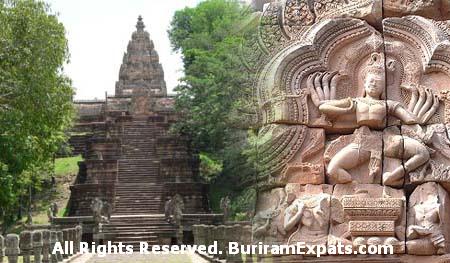
The picture in the seal is the stone temple of Phanom Rung. The dancing angel might illustrate the meaning of the city which means the ”pleasant City”.
Buriram is a large province with a small provincial town and a long history. Centuries ago, this province was part of the khmer empire, and for almost 400 years extended from Ankor in Cambodia to the North-east provinces. Today it’s ancient sanctuaries and ruins provide some of the finest examples of Khmer art in Thailand.
Buriram (Town of pleasantness) is the main town (thesaban muang) in Buriram Province, which is approximately 410 km Northeast of Bangkok and also 376 km by train.
The town is located on the northeastern railway line, and also has a regional airport, Buriram Airport which is located 35 km from Buriram town heading towards Satuk. Much of the local economy is still agricultural and the tourist industry that is a prominent feature in much of the rest of the country has yet to make a Significant impact. Key agricultural crops include rice and cassava. The main languages spoken in Buriram are central Thai, Lao, and Khmer 1.6 million people. Buriram town has a population of about 30,000 people. A census was taken in 2009 on how many farang’s (westerners) lived in Buriram and that total came to 900 people. (probably retiree’s who have come to relax).
BURIRAM CITY MAP View แผนที่เมืองบุรีรัมย์
City Pillar Shrine in Buri Ram Province ,Thailand.
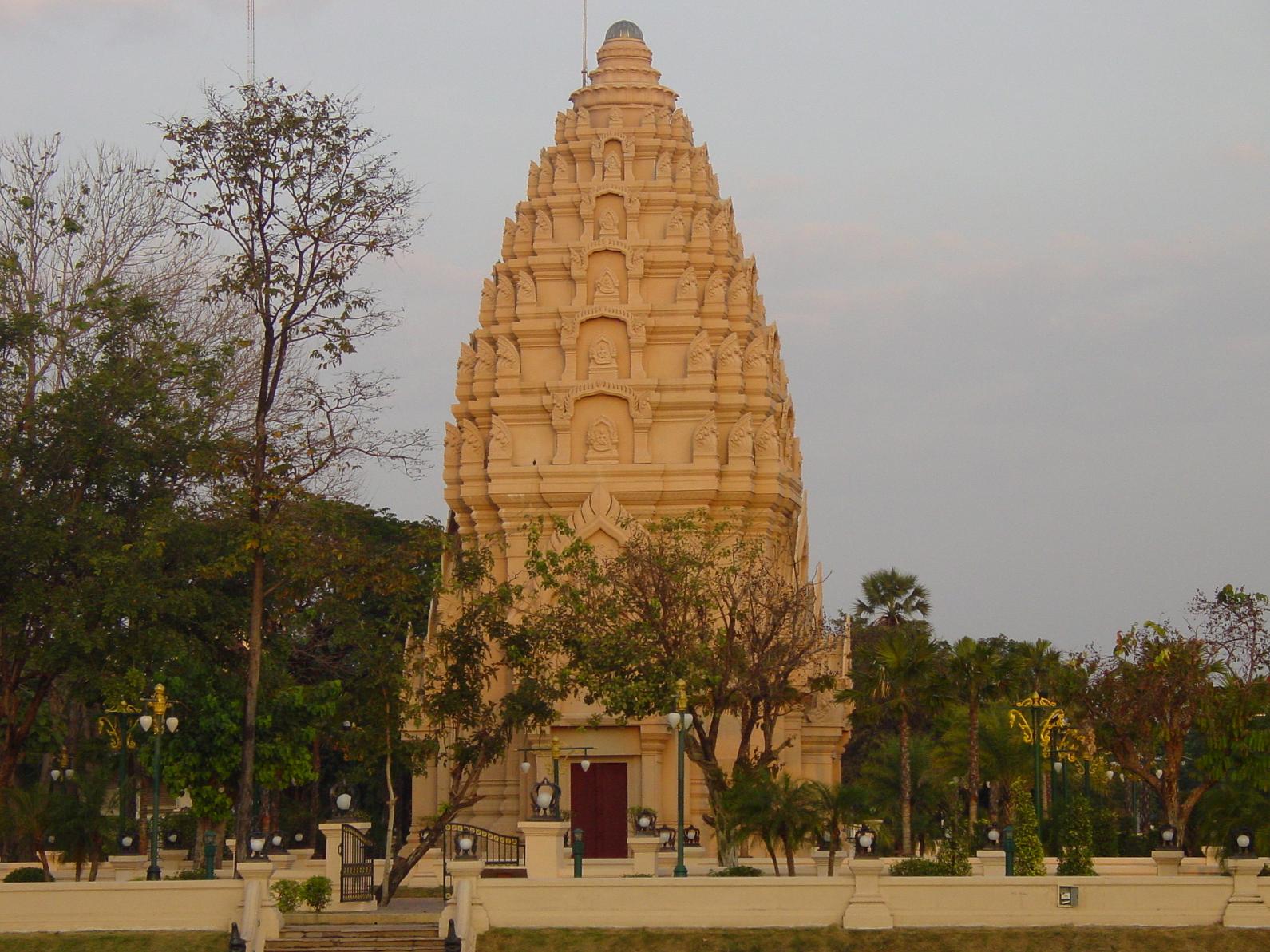
no images were found
Distances from Amphur Muang(Buriram city) to other Amphurs:
– Amphur Ban Kruat 66 km.
– Amphur Ban Mai Chaipot 85 km.
– Amphur Chalerm Prakiat 68 km.
– Amphur Huai Rat 12 km.
– Amphur Khu Muang 33 km.
– Amphur Krasang 32 km.
– Amphur Lahan Sai 100 km.
– Amphur Lamplaimat 32 km.
– Amphur Na Pro 78 km.
– Amphur Nang Rong 54 km.
– Amphur Non Din Daeng 92 km.
– Amphur Non Suwan 40 km.
– Amphur Nong Hong 60 km.
– Amphur Nong Ki 83 km.
– Amphur Pa Kham 78 km.
– Amphur Plab Pla Chai 40 km.
– Amphur Prakhonchai 44 km.
– Amphur Putthaisong 64 km.
– Amphur Satuk 40 km.
– King Amphur Ban Dan 15 km.
– King Amphur Kan Dong 56 km.
Tour Attractions in Buriram:
The major tourist attraction in Buriram is Phanom Rung historical Park.
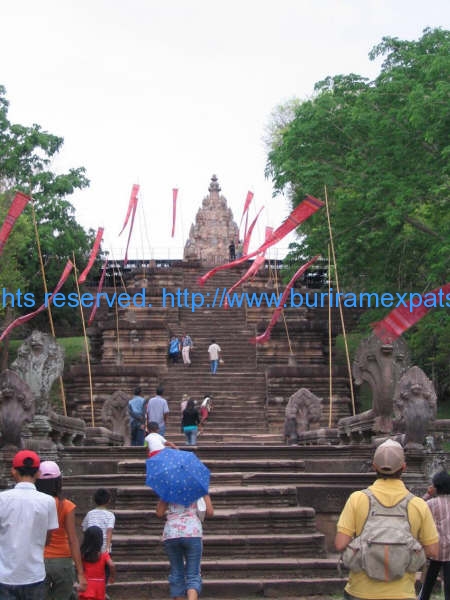
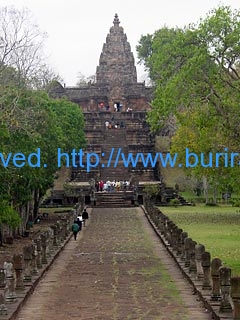
Prasat Hin Khao Phanom Rung is a Khmer temple Complex built from Sandstone in the 10th Century Located about 75 km’s from Buriram Town on the road between Nang Rong and Prakonchai.
Phanom Rung was built on top of a hill which is believed to be an extinct volcanic cone , 1,320 feet above sea level. Archaeological and historical studies show that this place was originally built to worship Shiva , the Hindu God between the 10th and 13th Centuries with the bulk of the work being completed during the reign of King Suriyavaraman II. The site was in a state of disrepair and neglect in the early 20th Century , then in 1971 Thailand’s Department of Fine Arts spent 70 million Baht and 17 years restoring the complex to it’s original state. Finally completing it for it’s reopening on the 21st May 1988 , officially opened by Princess Maha Chakrisirindhorn. It is now one of the most famous attractions in the Northeast of Thailand. In 2005 the temple was submitted to UNESCO for Consideration as a future world heritage site.
The lintel of the God Vishnu
One major art piece is the stone lintel of the God Vishnu which once disappeared from the complex in the early 1960’s. There was a suspicious helicopter heard in the area by the villagers about this time. Even more peculiar , the four administrators of the complex at the time have all met misfortune and mysterious ends since the stone lintel disappeared. It could be the curse of the lintel , so the locals call it.
The story has a happy ending when in March 1973 the lintel reappeared in the institute of Chicago in America. “The lintel had been donated by a James Alsdolf. The Thai government and many private sectors tried for many years to return the lintel back to it’s place. Finally a price was negotiated , and in November 1988 the lintel was returned and placed in it’s original position.
Architecture
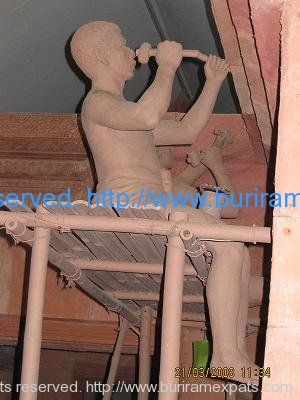
After a steep three – leveled lower stairway and a rocky mound , the visitor finds himself on the first cruciform platform with a first glimpse at the main temple. This is when the visitor gets a sense of eeriness of being taken back in time.
On the right, northward is Phlab Phla or the white Elephant House.
The pavilion is believed to be the place where Kings and the royal family would change attire before rituals. Royalty would then enter the processional walkway one of the most impressive elements of the park. It is 160 meters long and bordered by seventy sandstone posts with tops of lotus buds. The walkway itself is paved with late rite blocks.
The walkway leads to the first of three naga bridges. The five – headed snakes face all four directions and are from the 12th Century. This bridge represents the connection between heaven and earth. The naga bridge leads to the upper stairway , which is divided into five sets. Each set has terraces on the sides. The last terrace is wide , made with late rite blocks. It has a cruciform shape and four small pools. A couple more steps lead to the second naga bridge. It has the same shape as the first one , only smaller.
In the middle the remains of and eight petaled lotus carving can be seen.
The bridge leads you directly into the main sanctuary. After the antechamber and annex , one reaches the principal tower. Double porches lead out in all directions. The inner sanctum used to have the “lingua” , the phallic symbol of Shiva. Currently , only the “somasutra” remains which was used to drain water during religious rites. The entrances have various stories the dancing Shiva and the five Yogi’s. The southern entrance is guarded by a sandstone statue.
Festivals held on the site
Phanom Rung Festival is held annually in April to commemorate the restoration of Phanom Rung. The activities include the procession up Phanom Rung hill , sound and light presentations and dances are performed. It also coincides with at sunrise usually , in the first week in April. A special occurrence happens when at dawn at a special moment the sun shines through the main corridor and produces and unique sight.
There is also the Phonom Rung Fun run ( mini-marathon ) held every year On December.
Prasat Hin Muang Tam
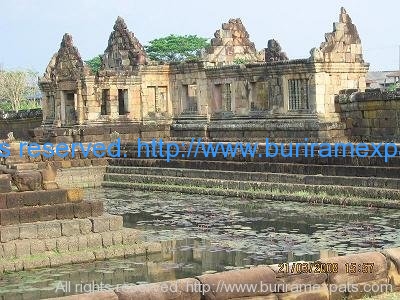
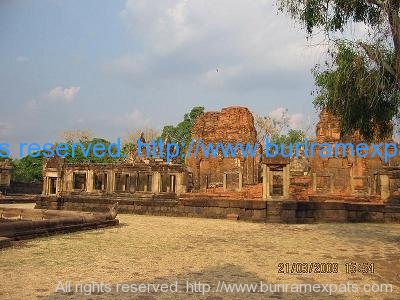
Muang Tam is a stone temple located near Prakhon Chai. It’s about
5 km’s from Phanom Rung national park. King Jayavaraman II was responsible for this magnificent premises made up of five ancient ‘Prangs’ set around four lotus ponds and enclosed by a late rite wall.
All in all with two magnificent well kept sites only 5 km’s apart , It is a wonderful day out which you will never forget.
Wat Kao Angkhan
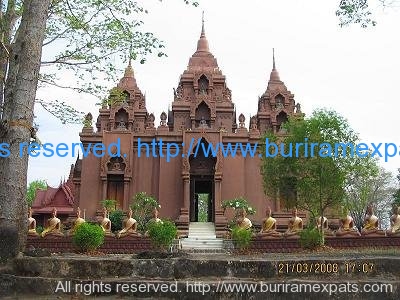
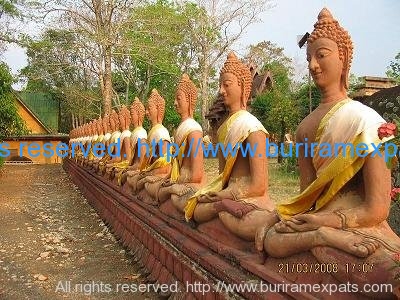
Wat Angkahn is located on Kao Angkhan, an extinct volcano. It takes 20 km. from Prasat hin Phanom Rung..there was a discovery of an ancient archeological site and many stone boundaries of temple(Sema) in Dvaravati era. Today, it is one of the most beautiful huge temples in Buriram. The monastery, pavilion, and other buildings imitate various ages’ architecture in different styles. And inside the monastery, there is also a mural illustrated Jataka tales in English.
Other Tourist attractions in Buriram
Khao Kradong mountain and Phra Suphattha Bophit.
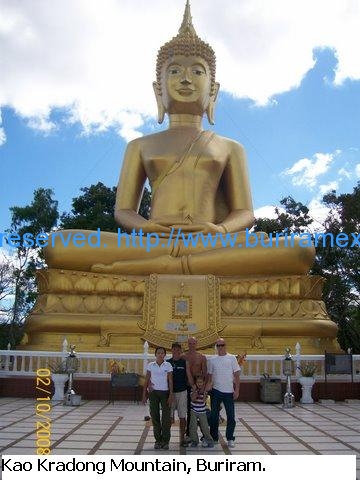
Phra Suphattha Bophit is a Buddha image on Kradong hill about 6 km’s from the provincial township. There is also the replica of Lord Buddha’s footprint enshrined in the temple.
Khao Kradong Park is also located 6 km’s from the town of Buriram on the Buriram Prakhonchai Road. The image of Buddha can be reached by two ways , bye car on a concrete road which Snakes around an extinct volcano. Or on foot by a stairway which climbs to a level of 265 meters above sea level. Also there is the Bunyanusat Boy Scout Camp and smill zoo , the location is ideal for picnics and family relaxation.
Huai Talat Reservoir and bird sanctuary

Located about 10 km’s along Buriram-Prakhonchai Road in Sakaesum subdistrict. The reservoir holds water the whole year round.
Buriram local Arts and Crafts Center
Located opposite the Surin Provincial Army Headquarters on the Buriram crossroads from the Buriram-Prakhonchai Road in Samet subdistrict.
The Buriram Culture Center
Located on the campus of Buriram Ratchaphat University. It is the center for the collection and display of artifacts and works of historical value as well as a research source for local history , archeology and arts.
Amphoe Ban Kruat
Ancient Quarry is the site where the ancient khmer people used to obtain rocks to build sanctuaries in the lower northeast side. It is near Khao Kloi and Khao Krachiao , adjacent to the Thai-Cambodian border , 7 km’s from Kruat on the Ban Kruat-Lahan Sai Road and 3 k m’s from the main road.
Tao Sawai and Tao Nai chian Ancient Kilns are located 5 and 10 k m’s away from Amphorae Ban Kruat. The kilns had been used in the production of glazed pottery during the period of khmer dominance in this area , about the 9th to 10th Centuries AD.
Lam Nang Rong Dam
This earth dam with it’s concrete base , is located in Lahansai district. It is a recreation site for local people and visitors.
Prang Ku Suan Tang
This “Ku” or small khmer style stupas are located in Phutthaisong district. The stupas are built of brick and mortar. The door panels are carved showing the story of Ranmayana.
The ancient Khmer style spire of square-shape foundation piled up to the top with sandstone houses an earthen Buddha image.
Northeastern Kite Festival

The Festival is held annually in the Muang district in December.
A beauty contest and an Aek Kite Competition are scheduled.
Aek kite ( Ancient yoke shaped kite ) when flown in the air looks like two kites attached to one another.
Buriram Boat Racing in Satuek district.

Boat racing in Satuk district is also a popular festival.
This colorful festival occurs annually on the first week of November on the Mun river in Satuk District.
2010 Schedule:
On Saturday and Sunday 6th – 7th November 2010 at the Mun River, Satuk district, Buriram province. The activities are as below:
– Views the boat procession respectfully engage the King’s Cups.
– The competition of elephants swimming across the mun river.
– 2nd photo contest , View a photo exhibition that was awarded in the past year and many more activities.
– The street of safety food festival, stage performances, singing contest, the healthy elderly contest on 3rd – 7th November 2010.
– Shopping OTOP products ( OTOP is the brand of products under the ‘One Tambon One Product’ project ).
– Amusement park and Entertainment throughout the day.












